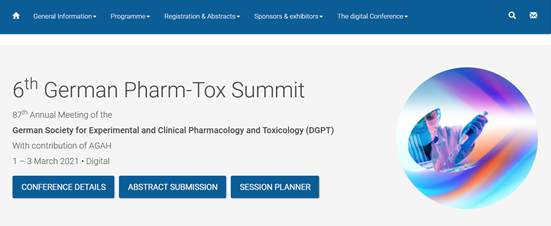Conference News 2021
This year’s 6th German Pharm-Tox Summit, the 87th Annual Meeting of the German Society for Experimental and Clinical Pharmacology and Toxicology (DGPT) was held as virtual conference 1–3 March 2021.
Several interesting presentations on the large world of TRP channels were eluting on Idiopathic Pulmonary Fibrosis (IPF), Inflammation and Wound Healing.
TRPA1 and IPF
Primary human fibroblasts treated with TGF-ß1 reduce the expression of TRPA1 while leaving the expression of other TRP channels from the TRPC, TRPM, and TRPV class unaffected. Fabienne Geiger from Munich reported that the effect was similar to TRPA1 siRNA treatment and both treatments reduced AITC-induced Ca++ influx. Both, TGF-ß1 and TRPA1 siRNA treatment led to elevated levels of extracellular matrix proteins including PAI-1 and αSMA. In summary, the data suggest a potential role of human TRPA1 in IPF. Interestingly, a high expression of TRPA1 was found in human lung fibroblast but not in mouse fibroblasts. Bearing in mind the known poor translational value of mouse models for human IPF, assessment of primary human pulmonary fibroblasts can add to the translational puzzle in this indication which still comes with a high medical need for efficacious treatments.
TRPV2 and Inflammation
X10056, a novel TRPV2 blocker identified from a KIT compound library by Rick Raudszus in Leipzig is an interesting tool (IC50 of 6 µM) and was characterized with the help of RNA interference. The compound blocked TRPV2-mediated Ca++ influx and currents in TRPV2 transfected HEK cells and in mouse bone marrow derived macrophages. Functional assessment of macrophage functions such a phagocytosis or cell migration was attenuated by both X10056 or siRNA against TRPV2 suggesting TRPV2 antagonists as potential anti-inflammatory target. Human target validation will be an important step for future research.
TRPV3 and Wound Healing
KS0365 was presented by Marion Maier from Leipzig and represents a novel TRPV3 agonist as shown by an EC50 of 4.5 µM on Ca++ influx in TRPV3 transfected HEK cells. The compound induces TRPV3-dependent migration of keratinocytes in 2D preparation assessing the closure of scratches in the confluent layer of keratinocyte cultures. Analysis of Ca++ imaging in these cultures revealed a KS0365-dependent higher Ca++ influx in cells proximal to the scratch as compared to more distal locations. Subcellular localization studies revealed an intracellular gradient in Ca++ influx with higher influx at sites which are directing towards the scratch, representing a potential wound. The data suggest a potential beneficial role of TRPV3 in wound healing.

